Stained glass window film is a contemporary alternative to leaded or painted glass windows. It is a thin, adhesive-backed vinyl that may be immediately put into existing windows to improve the look of architectural spaces.
Stained Glass Window Film allows you to create stunning effects on glass. High-specification optically clear vinyl for advertising on glass surfaces. Applied internally, the film has long-term usage. For viewing externally, the vinyl would be printed in reverse and applied to the inside of the glass. Creates stunning effects for retail display, including stained glass simulation. You are printed at high-resolution 1440dpi for superb reproduction of your designs.
3-year 80 microns ultra clear high gloss monomeric film with an ultra-clear permanent adhesive. Our clearest vinyl for windows with a clarity that rivals more expensive polyester.
For high-quality window graphics where a ‘no vinyl’ look is preferred.
Stained glass window film was developed as a low-cost alternative to traditional stained glass windows, which may be costly to manufacture and instal. Stained glass windows are traditionally constructed by putting together small pieces of coloured glass and then soldering them together using lead cames, or strips of lead. This technique is time-consuming and requires a competent specialist to complete.
Stained glass window film, on the other hand, is made by printing designs and colours onto a thin vinyl substance. On one side, this material is covered with an adhesive, allowing it to be attached directly to the surface of a window. The installation process is pretty straightforward and may be completed by homeowners with some DIY skills.
The adaptability of stained glass window film is one of its main advantages. It may be employed in various situations, including homes, offices, and public structures. It is also available in several styles and motifs, ranging from geometric patterns to nature or religious themes.
Like a standard window, the film is also reasonably simple to maintain. Depending on the kind of film, it may be cleaned with a light soap and water solution and removed without hurting the surface of the glass. Some films additionally provide UV protection or privacy.
Stained Glass Window Film History
Stained glass window film is a contemporary spin on a traditional art form that has been used for ages to beautify architectural spaces. Stained glass has its roots in the ancient Roman Empire when glass was employed to bring colour and adornment to windows in public buildings and houses.
The use of stained glass in architectural settings peaked during the Gothic period in the Middle Ages. Stained glass windows of Gothic cathedrals, such as Notre Dame de Paris and Chartres Cathedral, narrate religious stories and show saints and other religious people. These windows were made using a process known as “leading,” which involves cutting pieces of coloured glass to form and holding them together with lead cames, or strips of lead.
The use of stained glass diminished throughout the Renaissance as the emphasis switched to producing more prominent, more decorative windows that let in more light. During this period, painted glass, which entailed adding paint directly to the surface of the glass, became more popular.
New technology enabled the production of vast sheets of coloured glass, known as “rolled glass,” with the growth of industrialisation in the nineteenth century. This advancement resulted in the production of stained glass windows for churches and residences.
The advent of new types of glass, such as laminated and tempered glass, in the twentieth century, resulted in the development of contemporary architectural design trends. However, it was not until the late twentieth century that new technology and materials enabled the creation of stained glass window film.
Stained glass window film is a contemporary alternative to leaded or painted glass windows. The film is a thin, adhesive-backed vinyl that may be immediately placed on existing windows. It can be tailored to fit any size or shape of the window and comes in various colours and styles.
Stained glass window film is an inexpensive and straightforward method to bring colour and elegance into any architectural area. It is a means to create a unique and aesthetically attractive environment in homes, offices, and public structures.
Stained glass window film may now duplicate the beauty of real stained glass for a fraction of the cost without the weight and fragility of the traditional material. It also has the benefit of being changeable because it is not permanent.
Finally, stained glass window film history continues the old art form providing colour and beauty to architectural spaces. This contemporary interpretation of classic stained glass allows individuals to enjoy the visual benefits of this art form more practically and cost-effectively.
Stained glass window film varieties
Various types of stained glass window film are on the market, each with its distinct features and characteristics.
The “opaque” or “solid” film is a typical stained glass window film. This film is fully opaque, meaning no light can flow through it. Opaque stained glass window film is perfect for private areas such as restrooms or bedrooms. It may also provide a decorative touch to a room by covering a single or partial window.
The “semi-opaque” or “frosted” film is another stained glass window film form. Semi-opaque stained glass window film is perfect for use in locations where seclusion is sought, but natural light is also required, such as corridors or entryways. This sort of film enables some light to get through while maintaining privacy.
The “transparent” film is a third stained glass film form. This film is fully transparent and provides the most incredible light transmission. Transparent stained glass window film is ideal for usage in spaces where natural light is wanted, but privacy is not a problem, such as living rooms, kitchens, or home offices.
Special effect films are also available, such as those that give a prism effect or protect the interiors from UV rays.
The “textured” or “faceted” film is another popular stained glass window film style. This type of film has a range of textures and motifs, such as a diamond pattern, that give visual appeal to the window and serve to produce a one-of-a-kind and stunning appearance.
Furthermore, there are custom-made films built to particular architectural specifications and can complement the architecture of the building or create a specific historical style or theme.
Overall, several varieties of stained glass window film are available, each with its own distinct features and characteristics. When selecting a film, consider the quantity of natural light sought, the level of seclusion necessary, and the overall architectural aesthetic of the space or structure.
Finally, stained glass window film is a simple and inexpensive approach to enriching architectural spaces, with various alternatives available to meet individual demands and aesthetic preferences. With the multiple varieties of film available, choosing one ideal for any project, large or small is simple.
The Installation Procedure
The first step in installing stained glass window film is selecting the appropriate film for your project. It’s critical to think about how much natural light is sought, how much seclusion is needed, and the overall architectural aesthetic of the room or structure. After you’ve decided on the film, you’ll need to measure your windows to establish the proper size.
Following that, you must prepare your windows for installation. This includes carefully washing the surface of the windows to eliminate any dust, filth, or grime. To guarantee optimal adherence of the film, make sure the surface of the window is spotless.
After cleaning the window, you may begin the installation process. Have a friend or family member assist you with this step to ensure that the film is put uniformly and without wrinkles or bubbles. To assist the film glide into position and remove any air bubbles, a spray solution of water and soap is often used to apply the film.
Once the film is in place, use a squeegee or similar instrument to smooth any wrinkles or bubbles. This will help to guarantee that the film adheres correctly to the window’s surface.
It is advised that the film be undisturbed for at least 24 hours after application to guarantee adequate adhesion to the surface.
The next step is to clip any surplus film from the window’s edges. This may be accomplished using a utility knife or scissors. Some films also come with a pre-cut pattern, so all you have to do is apply it to the window, and the design will be there.
Some films may be placed or removed, but others are intended to remain permanent. Before beginning the installation procedure, read and follow the manufacturer’s instructions for your type of film.
In conclusion, applying stained glass window film is a simple and inexpensive approach to enriching architectural spaces, and it is doable by homeowners with a bit of DIY enthusiasm. The installation procedure is pretty simple, and you may obtain professional-looking results with the correct equipment and skills. Keep in mind that the process and ultimate result may vary based on the kind of film, the state of the window, and the installation technique used, so read the directions carefully and prepare appropriately.
The Advantages of Stained Glass Window Film
Stained glass window film is a low-cost and adaptable substitute for conventional stained glass windows. It is a thin, adhesive-backed vinyl that may be immediately put into existing windows to improve the look of architectural spaces. The film comes in various colours and designs, making it an inexpensive and straightforward way to bring colour and beauty to any area in your home or business.
The adaptability of stained glass window film is one of its main advantages. It makes it simple to pick the ideal film for any large or small project. It may be employed in various situations, including homes, offices, and public structures. It is also available in multiple styles and designs, ranging from geometric patterns to renderings of nature or religious images.
Another advantage of stained glass window film is its low cost. Stained glass windows are traditionally constructed by putting together small pieces of coloured glass and then soldering them together using lead cames, or strips of lead. This procedure is time-consuming and requires the services of a trained specialist, which can be costly. Stained glass window film, on the other hand, is manufactured by printing images and colours onto a thin vinyl material, making it a more affordable choice.
Stained glass window film is straightforward to apply. The installation process is pretty clear and may be completed by homeowners with a little DIY attitude, saving additional costs associated with hiring specialists. Some films come with pre-cut designs, and you may produce professional-looking results with the correct equipment and skills.
Another advantage is that it enables for greater design and customisation freedom. Unlike traditional glass, where the design is permanent, you can quickly switch out other designs or patterns to fit your particular taste or complement the room decor.
Stained glass window film can give practical benefits in addition to aesthetic benefits. Some films can give privacy while allowing natural light to pass through, while others can provide UV protection to protect furniture and flooring from sun damage.
Stained glass window film is also extremely simple to care for. Depending on the kind of film, it may be cleaned with a light soap and water solution and removed without hurting the surface of the glass.
Finally, stained glass window film has several advantages, including adaptability, cost-effectiveness, ease of installation, design freedom, and practical benefits such as seclusion and UV protection. It is a cost-effective and simple technique to bring colour and charm to any architectural area. With so many possibilities on the market, it’s simple to choose the appropriate film for any project, big or little.
Stained glass window film design ideas
Stained glass window film is a contemporary alternative to leaded or painted glass windows. It is a thin, adhesive-backed vinyl that can be placed directly into existing windows and is relatively easy to instal. The film comes in various colours and styles, making it an inexpensive and straightforward solution to add colour and beauty to any architectural area.
When it comes to stained glass window film, the creative possibilities are practically limitless. However, with so many options available, choosing the best style for your room can be difficult. Here are some design pointers to get you started:
Consider the current décor in the room. When selecting a stained glass window film design, keep the room’s existing décor in mind. Consider a design incorporating vintage motifs such as flowers, foliage, or geometric forms if the area has a classic or antique atmosphere. If the area is modern, you could want to pick a design with clean lines and basic patterns.
Consider the room’s purpose. The room’s purpose should also be considered in the film’s design. If the area is a bedroom, for example, you may want to choose a style that gives seclusion while yet allowing in natural light. If the site is a home office, choose a design allowing plenty of natural light.
Make a focal point using colour. Colour may bring attention to the window and make it the main point of the space. For example, if your area has a neutral colour palette, you can employ a vibrant and bold design to enhance visual appeal.
Consider the window’s size. The design should be appropriate to the window size. More oversized windows can accommodate more elaborate and detailed designs, whilst smaller windows can be highlighted with simpler patterns.
Mix and combine various patterns. Different designs can be used to create a unified aesthetic in a room. You may, for example, put a different pattern on each panel of a bay window or combine different types of film to create a distinctive aesthetic.
Consider creating a one-of-a-kind design. If you can’t find the appropriate design among the pre-made designs, try working with a designer or customising one.
Consider the film’s lifespan and your readiness to replace it in the future.
Finally, stained glass window film may be utilised to enhance the colour and elegance of any architectural area. Choosing the right design might be difficult with so many alternatives available. However, considering the current décor, purpose, colour, size, and other aspects in the area, you may select a design ideal for your space. And don’t be scared to combine multiple styles or even construct a new one to meet your exact requirements.

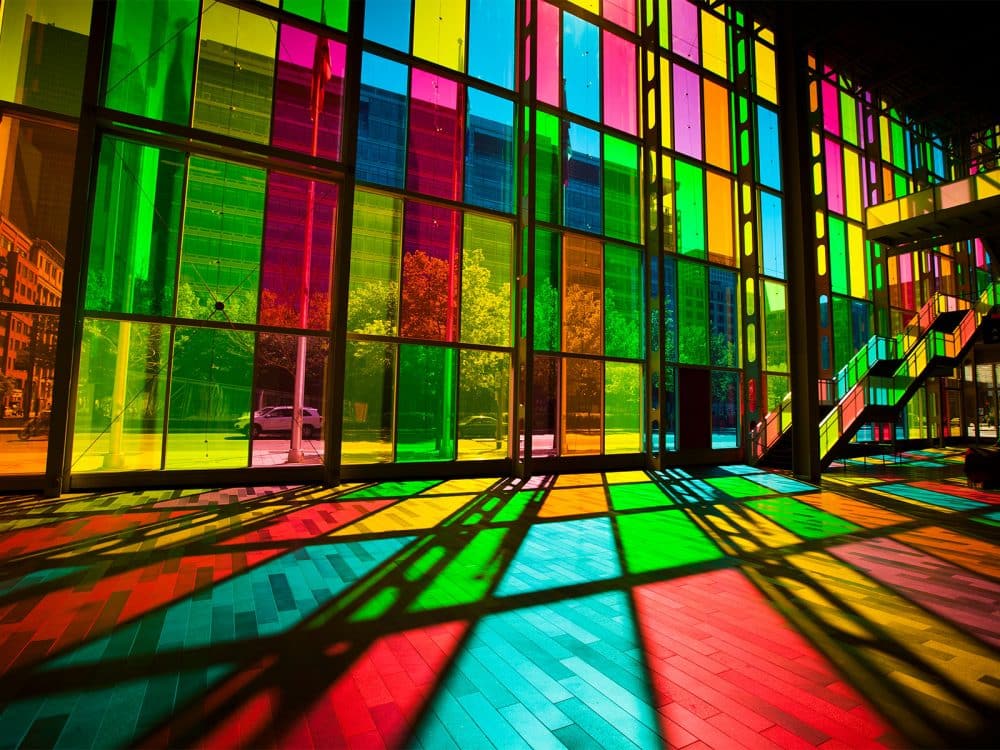
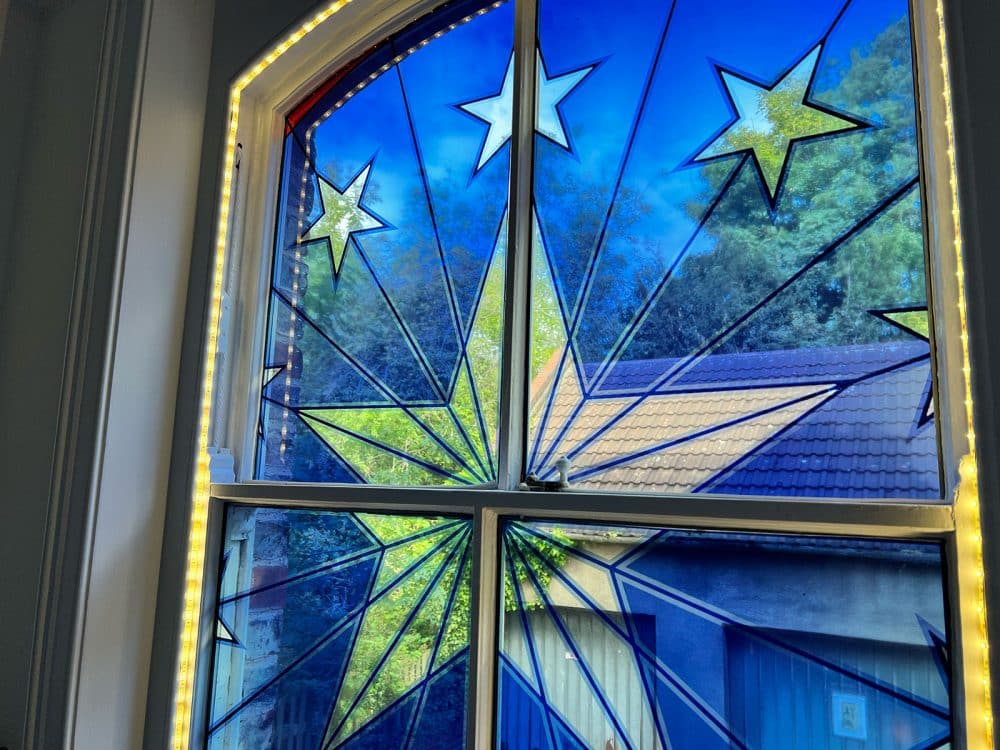
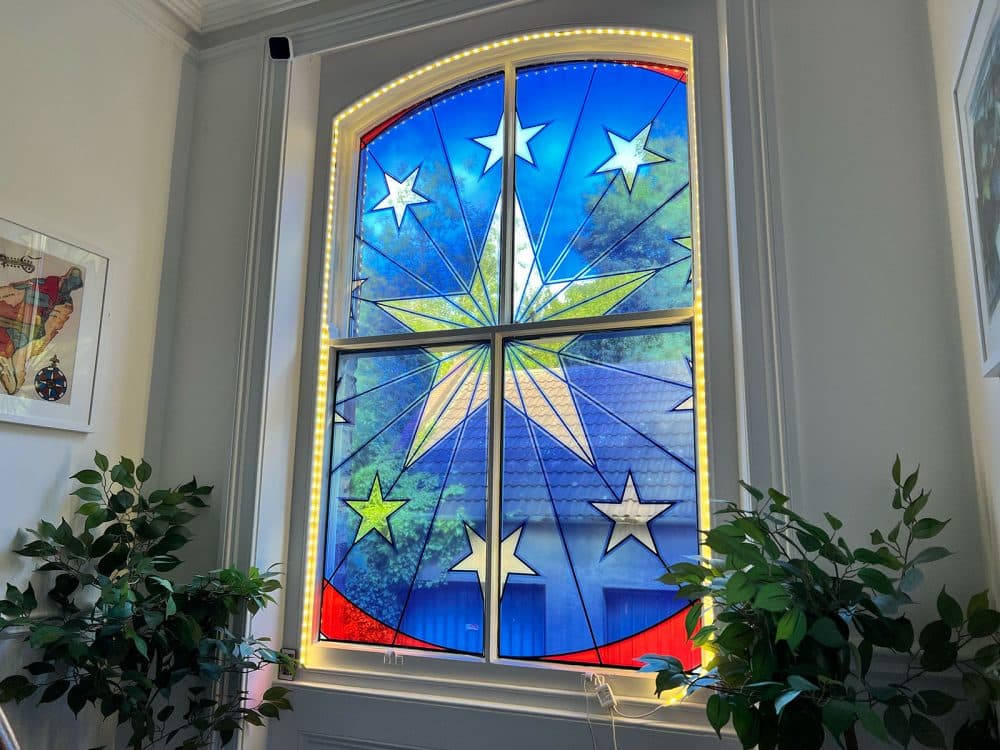
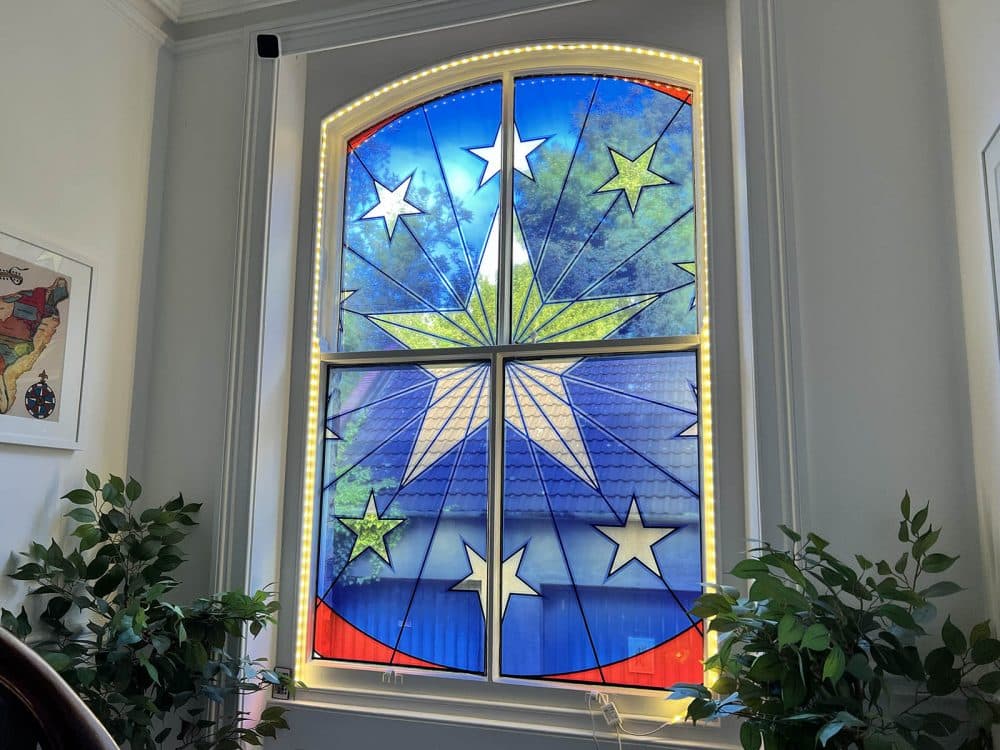
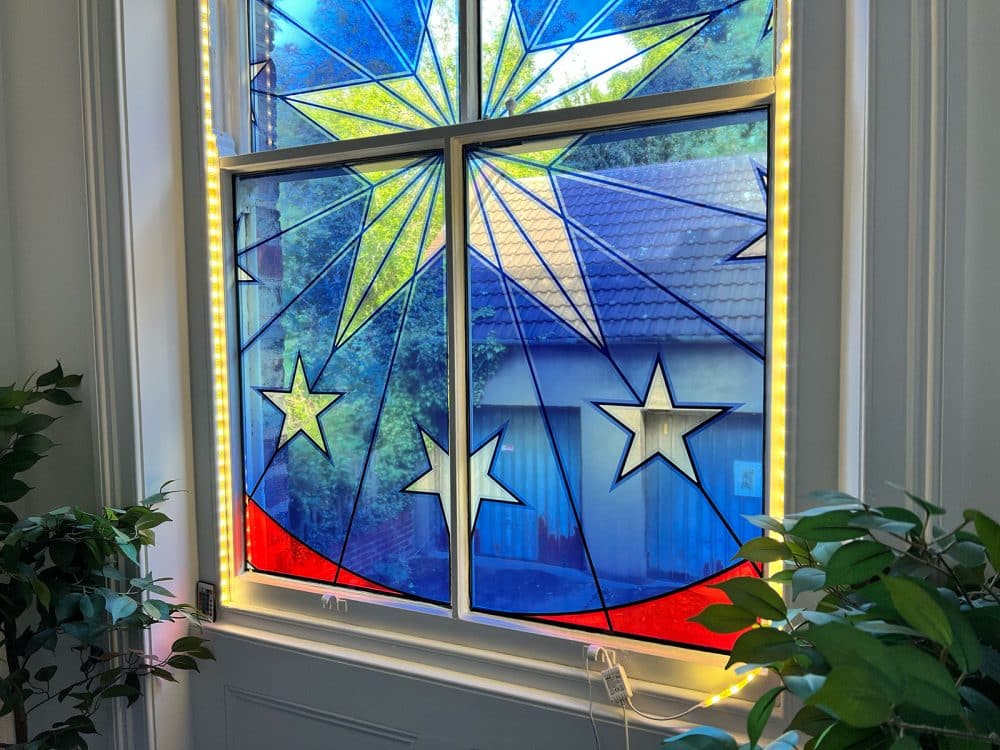

1 review for Stained Glass Window Film
HQ Couture (verified owner) –
Banner World advised us to go for this product after we had originally ordered something different. So pleased, the windows look amazing now.
Based on 113
Google Reviews